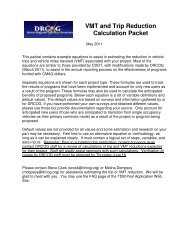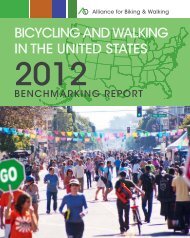Emerging Trends in Real Estate 2012 - Urban Land Institute
Emerging Trends in Real Estate 2012 - Urban Land Institute
Emerging Trends in Real Estate 2012 - Urban Land Institute
Create successful ePaper yourself
Turn your PDF publications into a flip-book with our unique Google optimized e-Paper software.
chapter 2<br />
<strong>Real</strong> <strong>Estate</strong><br />
Capital Flows<br />
“It’s a real estate market with<br />
too many dollars for too few opportunities.”<br />
The stock market bounces around produc<strong>in</strong>g a decadelong<br />
goose egg, and bonds throw off t<strong>in</strong>y yields. By<br />
default, capital turns to real estate: its cash-flow<strong>in</strong>g<br />
returns, lease structures, and <strong>in</strong>flation-hedg<strong>in</strong>g characteristics<br />
command attention. “When treasuries return next to noth<strong>in</strong>g, a<br />
6 percent coupon on a piece of real estate is not so bad,” says<br />
an <strong>in</strong>terviewee. But <strong>in</strong> today’s problematic market, always-fickle<br />
capital also proves “highly selective” and “concentrated.” It’s<br />
<strong>in</strong>terested <strong>in</strong> real estate, but only <strong>in</strong> a relatively narrow segment<br />
of the property markets, bidd<strong>in</strong>g up prices on the best commercial<br />
assets <strong>in</strong> the more secure wealth islands and rac<strong>in</strong>g <strong>in</strong>to<br />
the attractive multifamily sector. The rest of the underwater real<br />
estate landscape mostly misses out. When <strong>in</strong>stitutional <strong>in</strong>vestors<br />
talk up the property markets today, they really mean a handful<br />
of big cities, the best suburban fortress malls, and their latest<br />
apartment purchases. They have no <strong>in</strong>terest <strong>in</strong> most assets <strong>in</strong><br />
second-tier cities or outer suburban r<strong>in</strong>gs, many owned by borrowers<br />
whose mortgage balances outstrip values, which have<br />
fallen <strong>in</strong>to the pits. And why should they when the economy<br />
stays <strong>in</strong> the dumps and prospects appear so limited for any<br />
occupancy or rent growth<br />
For <strong>2012</strong>, the purveyors of capital will struggle with whether to<br />
cool it <strong>in</strong> the popular gateways, take a breather on apartments, or<br />
take a flyer on ferret<strong>in</strong>g out true barga<strong>in</strong>s among mostly commod-<br />
Exhibit 2-1<br />
Moody’s/REAL Commercial Property Price Index<br />
2.0<br />
1.9<br />
1.8<br />
1.7<br />
1.6<br />
1.5<br />
1.4<br />
1.3<br />
1.2<br />
1.1<br />
1.0<br />
0.9<br />
2001<br />
All Properties—National Index<br />
2002<br />
2003<br />
2004<br />
2005<br />
2006<br />
2007<br />
2008<br />
2009<br />
2010<br />
2011<br />
Source: Moody’s, <strong>Real</strong> <strong>Estate</strong> Analytics LLC, MIT Center for <strong>Real</strong> <strong>Estate</strong>, <strong>Real</strong> Capital Analytics.<br />
Note: This <strong>in</strong>dex is a periodic same-property round-trip <strong>in</strong>vestment price change <strong>in</strong>dex of the U.S. commercial <strong>in</strong>vestment property market. The <strong>in</strong>dex is based on the <strong>Real</strong> Capital Analytics database,<br />
which attempts to collect price <strong>in</strong>formation for every commercial property transaction <strong>in</strong> the United States over $2.5 million <strong>in</strong> value.<br />
<strong>Emerg<strong>in</strong>g</strong> <strong>Trends</strong> <strong>in</strong> <strong>Real</strong> <strong>Estate</strong> ® <strong>2012</strong><br />
15




